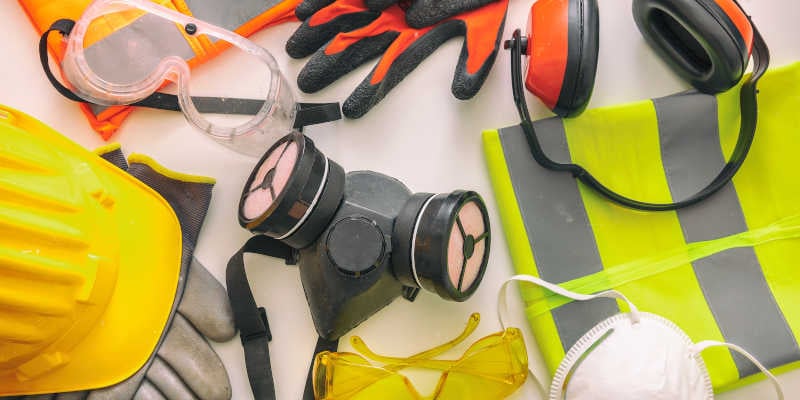Similar to legal malpractice suits, uncovered medi...
 Every workplace contains a variety of hazards that may expose employees to injury or illness. To reduce the potential of a workplace incident or injury occurring, all employers and businesses have the responsibility to implement effective strategies to protect employees from hazards they may encounter.
Every workplace contains a variety of hazards that may expose employees to injury or illness. To reduce the potential of a workplace incident or injury occurring, all employers and businesses have the responsibility to implement effective strategies to protect employees from hazards they may encounter.
Employers are required by the Occupational Safety and Health Administration (OSHA) to protect their employees from workplace injuries, hazards such as machines, work procedures, and hazardous substances that can cause injury or illness.
Personal Protective Equipment (PPE) refers to the protective clothing that workers wear to reduce their risk of industrial injuries and keep job sites safe. Coming into contact with chemical, electrical, mechanical, or physical risks can cause these injuries and illnesses. Gloves, safety goggles, safety shoes, earplugs, hard hats, masks, vests, and respirators are examples of protective equipment.
PPE programs involve specific PPE component information, usage, training, and documentation for gloves, gowns, shoe covers, head covers, masks, respirators, hearing, rain gear, eye protection, face shields, and goggles.
An effective PPE program requires commitment and active participation from all levels, including senior management, supervisors, and workers, during the planning, development, and implementation stages. The greater the workers' involvement in all phases of the PPE program, the more smoothly the program will be implemented. A good PPE program must include the following components:
We have found that there are four keys to implementing a successful PPE program, these include:
The first step and most important in developing a PPE program is to identify the specific hazards that your employees face on the job. A PPE hazard assessment is a tool that can help you identify what hazards your employees are exposed to and how to protect them most adequately.
When PPE is identified as a method to protect your employees from a specific hazard, the hazard assessment can help you determine what PPE is needed. You must conduct a documented hazard assessment of your workplace in order to start your program evaluation.
Now that the workplace hazards have been identified, the employer or supervisor must determine the adequacy of the PPE that is currently available and, if necessary, select new or updated equipment that provides a level of protection that is greater than the minimum needed to protect the employees from the hazards.
To ensure that correct PPE is used, the comfort and fit must be carefully considered. Are employers providing employees with a variety of styles? There are no shortcuts when it comes to PPE selection, so select the appropriate PPE for the hazard. Because the same task is performed on some jobs throughout the entire job cycle, selecting appropriate PPE is simple.

Workers should be educated on the nature of the hazard to which they are exposed, what the company has done to reduce exposure levels, the benefits and limitations of personal protective equipment, and why workers should use personal protective equipment.
Employees should be educated to understand when personal protective equipment is required, what forms or reporting is required, how it is to be used, worn, and what its limitations are, as well as how to properly care for it: maintenance, useful life, and disposal.
Employers must certify in writing that training was completed and that employees are aware of it. Each written credential must include and contain the name of each trained employee, the date(s) of training, and identify the certified subject purpose.
The effectiveness of the PPE program, like any other program or procedure implemented in an organization, should be monitored through inspection of equipment and auditing of procedures. Although annual audits are common, it may be necessary to review critical areas more frequently.
Documentation of education and training, personal protective equipment use, and medical examination results should be kept as long as possible. These records can be used to evaluate compliance, the effectiveness of the protective equipment, and as a resource to study risks associated with your hazards over time, as well as in cases of compensation claims.
All employers and worker's primary concern should be safety. Accidents are prevalent in all business as a result of the lack of or insufficient usage of personal protective equipment. An effective PPE program helps reduce the likelihood of accidents and lowers employers risk, while keeping employee safe.
Leap | Carpenter | Kemps Insurance Agency provides Commercial Business Insurance, Employee Benefits, Life and Health Insurance, and Personal Insurance to all of California, including Merced, Atwater, Los Baños, Mariposa, Madera, Fresno, Modesto, Turlock, and Stockton. Contact us today.
Similar to legal malpractice suits, uncovered medi...
You get all the benefits and advantages of being a...
Natural disasters and crimes can impact a business...
Leap | Carpenter | Kemps Insurance Agency provides Commercial Business Insurance, Employee Benefits, Life and Health Insurance, and Personal Insurance to all of California, including Merced, Atwater, Los Banos, Mariposa, Madera, Fresno, Modesto, Turlock, and Stockton.
CA License Number 0646081 | Licensed to do business in California, Arizona, Hawaii, Idaho, Montana, Nevada, North Carolina, Oklahoma, Oregon, Virginia, West Virginia and Washington.
© Copyright 2023 Leap | Carpenter | Kemps Insurance Agency — Privacy Policy | Terms & Conditions.
Merced Office
3187 Collins Drive
Merced, CA 95348
Phone: (209) 384-0727
Additional Contacts
Toll Free: (800) 221-0864
Fax: (209) 384-0401